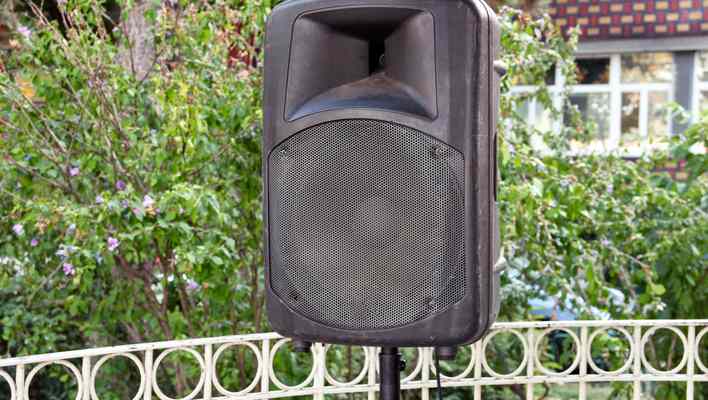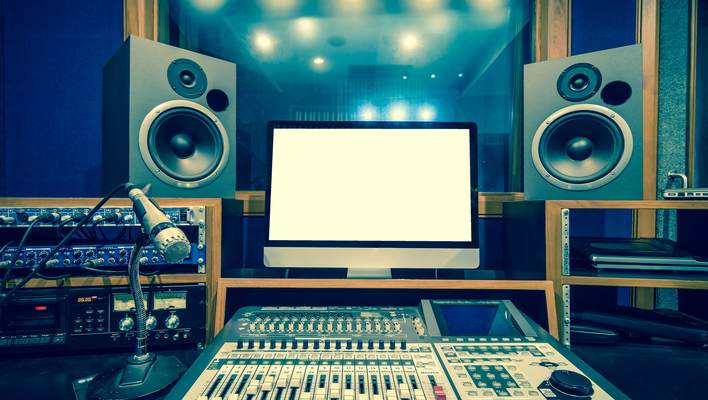Both studio monitors and PA speakers are types of loudspeakers used in quality sound reproduction. But, what’s the difference between a PA speaker vs studio monitor? Can you use PA speakers as studio monitors? Well, the answer to this is a simple” no”. You cannot substitute studio monitors with PA speakers, and the opposite is also true.
The reason behind this is that PA speakers do not provide the frequency response needed to deliver a good sounding mix. In addition, studio monitors are designed to deliver unfiltered sound, something that is not possible with PA speakers. On the contrary, PA speakers are merely used in venues and events to project sound to a large audience.
Perhaps the only similarity that they share is that they are both loudspeakers, and they both require some form of amplification. That said, let’s discuss the difference between the two loudspeakers in detail.
Studio monitors vs PA speakers; A Comparison of Features
Studio Monitors
Studio monitors are specially designed loudspeakers that are specifically made for professional or home audio production applications. They are often used for applications that require accurate audio reproduction, such as in filmmaking, recording studios, radio studios, and more.
Unlike other speakers which reproduce recorded sound in its final state, studio monitors are designed to deliver raw recordings without adding subtle colorations.
These speakers are generally compact and small enough to rest on a desk or speaker stands in close proximity to the audience or the central listening area. The idea behind this is to enable the listeners to enjoy sound directly from the speakers instead of sound reflecting off the walls or ceiling. Reflected sounds have high chances of picking up coloration or reverberation from the listening room.
Besides, having the monitor near the listening area delivers a tight and focused soundstage within a small space and with minimal interferences from room acoustics.
But as a general rule of thumb, the bigger the space, the bigger the monitors, and the more amplification is needed. For instance, if you’re mixing or listening to music in a small to medium-sized room, then a compact monitor with small drivers should serve you well.
On the other hand, if you are working in a relatively large area or looking to play at loud volumes, you may want to go for a high-powered model.
Just like other speakers, a studio monitor may feature more than one type of driver to allow you to fine-tune your music. For instance, it may include a woofer for monitoring bass sounds and a tweeter for the higher-end sounds.
A standard studio monitor will include several inputs and outputs that let you connect to multiple compatible audio sources. The most common inputs jacks include XLR, TSR RCA, or even a TS phone jack. Monitors also incorporate several controls, including equalization controls that allow you to fine-tune the sound depending on the room acoustics.
Powered vs Unpowered Monitors
Powered monitors or simply active monitors come with an inbuilt amplifier, meaning they do not require external amplification. These monitors have become a favorite for many for obvious reasons. A powered monitor saves you the hassle of dealing with extra equipment. This will come in handy when you have limited space in your studio.
Another benefit of using a powered monitor over a passive one is that the drivers and the inbuilt amplifier are factory-matched, so you can count on your monitor for a seamless response.

Placement of Studio Monitors
Studio monitors are generally placed on adjustable speaker stands, which helps ensure the tweeters are at the ear level. You can also place them on a desk, but you’ll need to ensure that the tweeters are at the ear level or directly pointing towards you.
If you are using two monitors, ensure that they are equidistant from the central listening area. However, stand placement yields the best results since it reduces the likelihood of sound reflecting off the desktop surface.

PA Speakers
PA (public address) speakers are loudspeakers that are designed to amplify human voice or musical instruments during live events. When you sing or speak into a mic, the signal is sent to the speakers where it is boosted by an amplifier. This interaction results in a much louder sound that you hear from your PA system.
The speakers are the main component in any PA system. They are tasked with the responsibility of reproducing indispensable sounds for the audience. Most arrangements have the speakers on both sides of the room, but large halls may have some at the rear walls or along the side walls.
Technically, PA speakers may need to be paired with a couple of microphones, a mixing console, and several amplifiers to ensure a wider sound distribution.
Like studio monitors, PA speakers come in both powered and passive forms. Powered speakers come with an amplifier inside the speaker cabinet, while with a passive one, the amplifier is separate from the speakers.
Powered speakers are easy to integrate into your PA system since you don’t need to configure the amplifier. In addition, these speakers are excellent for a portable system since you don’t have to drag amplifiers for every venue.
On the contrary, passive speakers are great for permanent installations like schools and music concert halls. Such applications require a considerable amount of power.
The most common sizes for PA speakers are 10″ and 12″ or even 15″ for high-end systems. When choosing your speaker sizing, you may want to consider the size of cabinets as well as the available space for the rest of the components in your PA system.
The size you choose is also going to depend on the amount of bass or level of loudness anticipated. For instance, if you prefer a lot of bass sounds, then bigger 15 inches models are the most ideal options, especially if you are not planning to add subwoofers.
Today, manufacturers are adopting one-in-all PA systems to deliver professional-grade sound in small spaces. However, these systems can be tuned to suit any room size. The combos are a great choice when portability is a major concern.
One key thing that we’d like to note is that PA speakers need to be paired with a powerful subwoofer or two of them. This is because, bass consumes a lot of power, so getting a dedicated subwoofer for the low-end sounds will allow the speakers to concentrate on other sounds in the spectrum range while making them sound clearer.
The Difference between Studio monitor vs PA speaker
One notable difference between a studio monitor and PA speakers is that the former is believed to produce close to zero sound coloration.
Ideally, PA speakers feature robust construction enabling them to withstand high volumes or accidental knocks during live performance. They are generally designed for use in public events that require you to be audible from a distance.
Contrarily, studio monitors are ideal for short-distance listening (near field). Monitors are also not only ideal for professional studios but also home-based projects.
Over the past years, self-powered studio monitors have taken the center stage, although there are still a good number of passive models out there. Whereas, PA speakers mostly require external amplification since they need to reproduce sound over a large area.
You may read: Audioengine HD3 vs A5+ Desktop Speakers: What’s Your Pick?
What we like about studio monitors over PA speakers
- Studio monitors offer a natural feedback of live recordings
- Studio monitors are ideal for both professional and home-related purposes
- They are the best choice for accurate listening
- Studio monitors also let you mix and edit a wide range of audio sources
What we like about PA speakers over studio monitors
- PA speakers are ideal for reproducing sound in larger spaces/ larger gatherings
- PA speaker provides a fuller and room-filling sound
- On-board mixers allow the speakers to be used for multiple purposes
- Delivers loud and high loud sound, but this will call for a powerful amplifier
Ultimately, your choice will be dependent on a couple of factors, including your specific sound needs, available space, and your budget.
Over to you!

